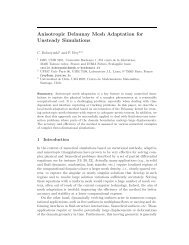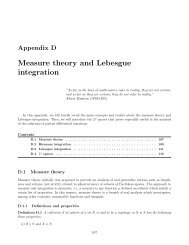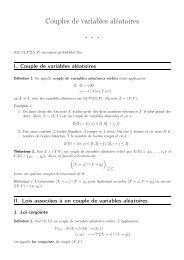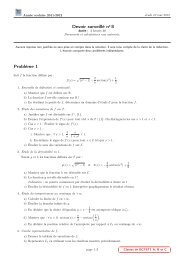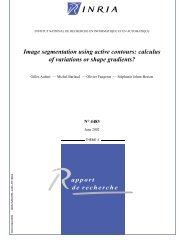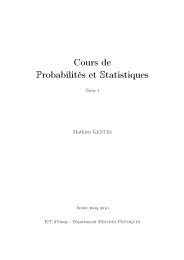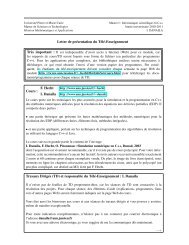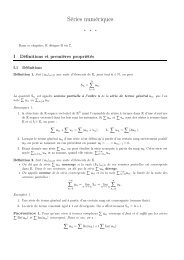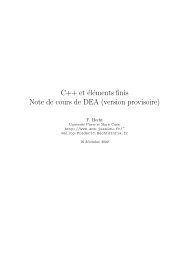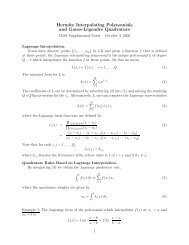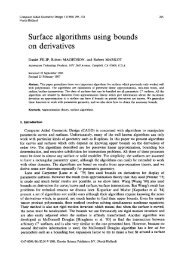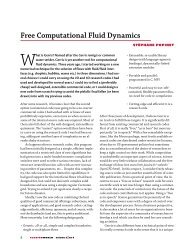pdf file
pdf file
pdf file
You also want an ePaper? Increase the reach of your titles
YUMPU automatically turns print PDFs into web optimized ePapers that Google loves.
BOGOLIUBOV SPECTRUM OF INTERACTING BOSE GASES 45<br />
Note that x �= 0 if u⊕v �= 0. Therefore, 0 is an eigenvalue of<br />
Xt := H +K − t2<br />
H −K .<br />
In fact, using Weyl sequences and arguing similarly, we also obtain<br />
t ∈ σ(ξ) = σ(SA) ⇔ 0 ∈ σ(Xt). (72)<br />
8. We show that the number of eigenvalues (with multiplicity) of ξ below<br />
µ := infσess(ξ) is equal to the number of negative eigenvalues of Xµ.<br />
Notethatthemappingt ↦→ Xt isstrictlydecreasing. Asaconsequence, for<br />
every j = 1,2,..., the min-max value λj(Xt) is a continuous and decreasing<br />
function on t ≥ 0. More precisely, if 0 ≤ t1 < t2, then λj(Xt1 ) ≥ λj(Xt2 )<br />
and the inequality is strict if λj(Xt1 ) is an eigenvalue of Xt1 . Moreover,<br />
and, for every t ∈ (0,µ),<br />
infσ(X0) = infσ(H +K) ≥ η > 0<br />
infσess(Xt) > infσess(Xµ) = 0.<br />
Therefore, by using (72), we obtain a one-to-one correspondence<br />
σ(ξ)∩(−∞,µ) ↔ σ(Xµ)∩(−∞,0). (73)<br />
9. From the inequality µ 2 (H −K) −1 +H −K ≥ 2µ we get<br />
Xµ = H +K − µ2<br />
H −K<br />
≤ 2(H −µ).<br />
Moreover, note that infσess(Xµ) = infσess(H −µ) = 0. Therefore, the number<br />
of negative eigenvalues (with multiplicity) of Xµ is not less than the<br />
number of negative eigenvalues (with multiplicity) of (H −µ) .<br />
In particular, if (H − µ) has infinitely many negative eigenvalues, then<br />
Xµ has infinitely many negative eigenvalues. By (73), we see that ξ has<br />
infinitely many eigenvalues below its essential spectrum. Consequently, H<br />
has infinitely many eigenvalues below its essential spectrum.<br />
10. Now we assume furthermore that K ≥ 0. Then we get the inequality<br />
Xµ = H +K − µ2 µ2<br />
≥ H −K −<br />
H −K H −K .<br />
Moreover, note that<br />
�<br />
infσess(Xµ) = infσess H −K − µ2<br />
�<br />
= 0.<br />
H −K<br />
Thus, if H − K has finitely many eigenvalues below µ, then Xt also has<br />
finitely many negative eigenvalues. By (73), ξ has finitely many eigenvalues<br />
below its essential spectrum. Consequently, H has the same property. �<br />
Appendix B. Localization of band operators on F+<br />
In this appendix we prove the localization in Proposition 22.<br />
Proof of Proposition 22. Using the IMS-identity<br />
A = fMAfM +gMAgM + 1<br />
2 ([fM,[fM,A]]+[gM,[gM,A]])



